Explore Papanatha Temple To Experience Divinity In 2026
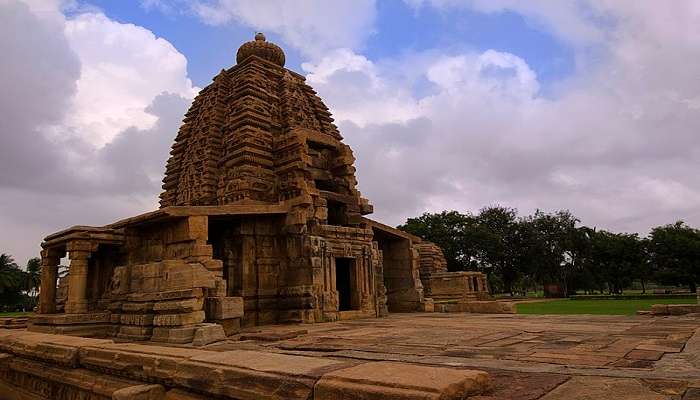
Nestled in the ancient ruins of Pattadakal, Karnataka, the Papanatha Temple stands as a testament to the architectural brilliance of the Chalukya dynasty. This 8th-century marvel, dedicated to Lord Shiva, captivates visitors with its unique blend of North and South Indian architectural styles. As you approach the temple, its imposing structure greets you with intricate carvings and detailed sculptures that adorn its walls. The sanctum sanctorum houses a majestic lingam, while the surrounding pillars and ceilings narrate tales from Hindu mythology through their exquisite reliefs. The Papanatha Temple isn’t just a religious site; it’s a living museum of India’s rich artistic heritage. Whether you’re a history enthusiast, architecture lover, or spiritual seeker, this UNESCO World Heritage site promises an unforgettable journey through time.
About Papanatha Temple
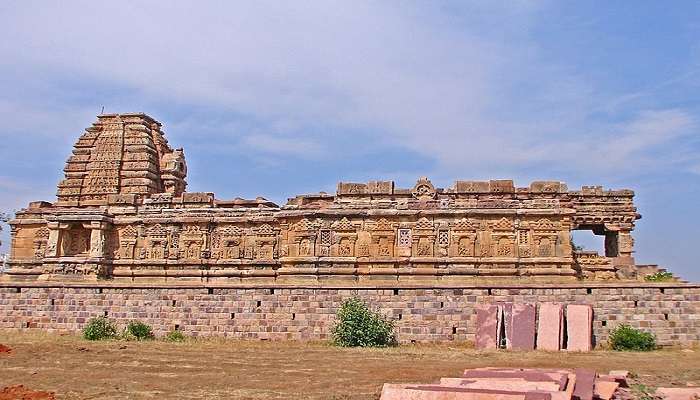
At a distance of 700 meters from Pattadakal Bus Stand & Temple Complex entrance, Papanatha Temple is a large structure built on the banks of Malaprabha River outside the main temple complex. Walking down the river bed from the Virupaksha Temple gateway, this temple can be reached. This temple is dedicated to Muktewara, a form of Lord Shiva. Built in a mix of Nagara and Dravidian architecture, this temple dates back to 680 AD. The vimana on top of the sanctum is built in Nagara style, while the mukhamandapa facing east, rangamandapa and antarala are acquired from Dravidian style. The sanctum has a narrow circumambulatory path for pradakshinas. On three sides of the outer walls of the sanctum, there are pillared porticos with sculptures of dancing Shiva.
This temple is famous for the carvings of scenes from Ramayana and Mahabharata. The sabha mandapa has 16 pillars with medium size sculptures of men & women. There is also a sculpture of Mahishasura Mardhini with 8 hands. The pillars in Mukhamandapa have beautiful carvings of couples and mythical animals on three sides. The sides of mandapa have several lattice windows with miniature temple towers engraved inside with different sculptures like Rama Killing Vali, Vanaras building bridge to Lanka, Srirama’s Coronation, Arjuna’s penance, Ravana lifting mount Kailash, Narasimha & Hiranyakasipa fighting, Indra riding Airavata, Dasaratha performing Putrakamesthti yaga, Indrajit & Kumbhakarna attacking vanara army, etc.
Must Read: Places To Visit In Pattadakal
Things To Do In Papanatha Temple

Papanatha Temple, located in Pattadakal, Karnataka, India, is a remarkable example of Chalukya architecture. Here are some things to do when visiting this historic site
- Admire the architecture: The temple’s unique blend of Nagara and Dravidian styles features intricate carvings and sculptures.
- Explore the interior: Walk through the temple’s mandapa (hall) and garbhagriha (sanctum sanctorum) to appreciate the detailed craftsmanship.
- Study the sculptures: Examine the mythological scenes and deities on the walls and pillars.
- Photograph the exterior: Capture the temple’s beautiful silhouette and ornate details, especially during golden hour.
- Join a guided tour: Learn from a knowledgeable guide about the temple’s history, significance, and architectural features.
- Meditate or reflect: Find a quiet spot to sit and absorb the spiritual atmosphere of this ancient place.
Places To Visit Near Papanatha Temple
Here are some of the places to visit near Papanatha Temple:
1. Virupaksha Temple

The largest temple in Pattadakal was built in the 8th century to commemorate the victory of Vikramaditya II over the Pallavas of Kanchi. Multiple inscriptions and stone carvings are featured on the stone mandapa. Sculptures of various Hindu Gods are housed in this temple. This is the only active temple in the Pattadakkal complex. This temple was made after the Kailasanatha Temple in Kanchipuram.
Entry Fees: INR 10
Timings: 9 am to 5 pm
Suggested Read: Places To Visit In Badami
2. Jain Temple
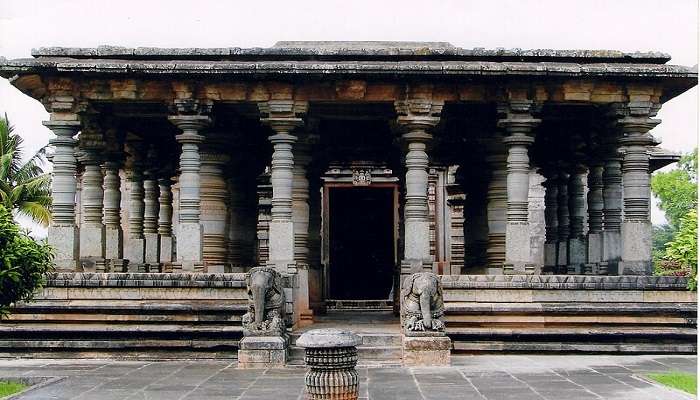
The Jain temple is built in the Dravidian architectural style and has various beautiful and intricate sculptures. It may have been built in the 9th century by King Amoghavarsha I or his son Krishna II. The structure has 16 round large pillars, and life-sized elephant statues adorn the entrance. The temple has a Shiva Lingam, which was placed after Jainism was taken over in the city. The temple was originally a Jain Temple.
Entry Fees: INR 35
Timings: 6 am to 6 pm
3. Mallikarjuna Temple
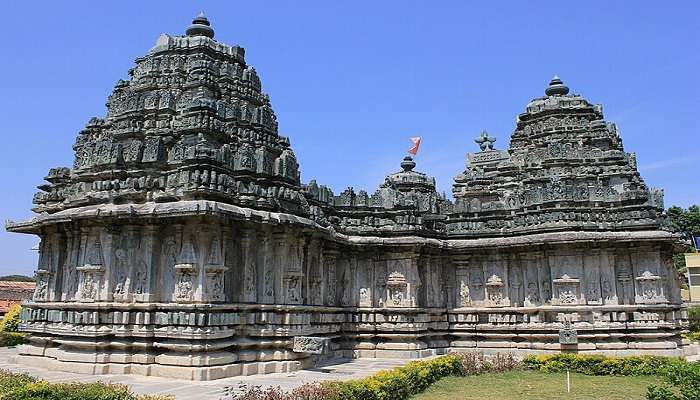
It was built during the 7th century using the Dravidian architectural style. It is a UNESCO World Heritage Site and is part of the stunning Pattadakal group of monuments. On the porch, there is a splendid image of Narasimha killing Hiranyakashipu. There are many beautiful carvings from the Mahabharata, Ramayana and the Panchatantra.
Entry Fees: INR 10
Timings: 6 am to 6 pm
Suggested Read: Hill Stations In Karnataka
4. Sangameshwara Temple
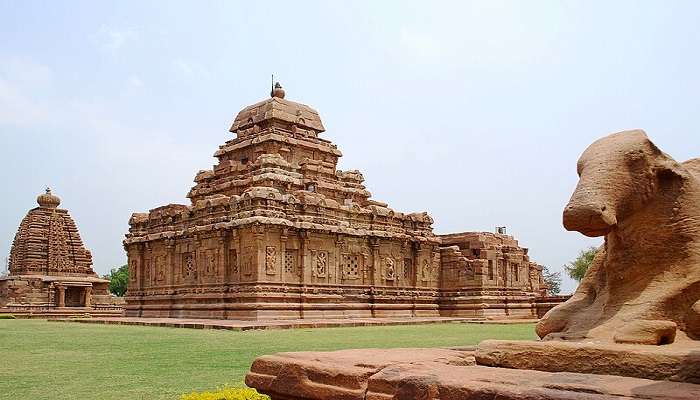
One of the oldest temples in India, it was constructed between 696 and 733 AD by the Chalukya King Vijayaditya Satyashraya. Displaying Dravidian architecture, it was earlier known as the Vijayeswara temple. The temple is known to be the first of the two-tier Sikharas, which has led to the feature being used even today. At the temple’s entrance is a Nandi mandapa as well.
Entry Fees: INR 10
Timings: 9 am to 5 pm
How To Reach

Pattadakal is located in Karnataka and is accessible by road from Bangalore, Belgaum and Badami. These cities, in turn, are well connected with the rest of India. Here is how to reach Pattadakal:
By Air: The nearest airport is Belgaum, about 180 km from Pattadakal. Flights from Indian cities like Mumbai and Chennai operate to Belgaum. The nearest international airport is Bengaluru.
By Train: Badami is the nearest railhead, about 22 km from Pattadakal. Trains from places like Solapur and Ahmedabad halt at the station. You can hire a taxi from the station or board a bus to reach Pattadakal.
By Road: Pattadakal is well connected by road. State-run buses ply regularly from Bengaluru, Bijapur, Hubli and Belgaum.
Further Read: Historical Places In Karnataka
Now that you have a list of things to remember for your next vacation to see the beautiful Papanatha Temple make sure you plan your trip to Karnataka to these fabulous spots for the experience of a lifetime. Don’t miss out on these opportunities; book your tickets now!
For our editorial codes of conduct and copyright disclaimer, please click here.
Cover Image Credit: Ganesh.Subramaniam85 for Wikimedia Commons
Frequently Asked Questions About Papanatha Temple
Where is Papanatha Temple located?
Papanatha Temple is situated in Pattadakal, a UNESCO World Heritage Site in the northern part of Karnataka, India. It's part of a complex of 7th and 8th-century temples that showcase the evolution of temple architecture in the region.
What architectural style does the Papanatha Temple represent?
The temple exhibits a unique blend of North Indian (Nagara) and South Indian (Dravidian) architectural styles, making it an excellent example of the transitional phase in Indian temple architecture.
What are the main features of Papanatha Temple?
Notable features include its ornate carvings, particularly those depicting scenes from the Ramayana and Mahabharata epics. The temple also boasts intricate pillar designs and a beautifully sculpted ceiling.
When is the best time to visit Papanatha Temple?
The ideal time to visit is between October and March when the weather is cooler and more comfortable for exploring the temple complex.
Are there any nearby attractions to combine with a visit to Papanatha Temple?
Yes, visitors can explore other temples in the Pattadakal complex, such as the Virupaksha Temple and Sangameshvara Temple. The nearby town of Aihole, another important centre of Chalukyan architecture, is also worth visiting.
People Also Read:
Banashankari Amma Temple Hemakuta Hill Temple Amareswara Temple

As a Travel Content Writer, I live to conquer the world of globetrotting with words. With my unquenchable thirst for storytelling, I believe that my words will inspire you to travel around the world’s breathtaking landscapes. As for me, I am an unapologetic selenophile, who loves to wander around in a starry night!











